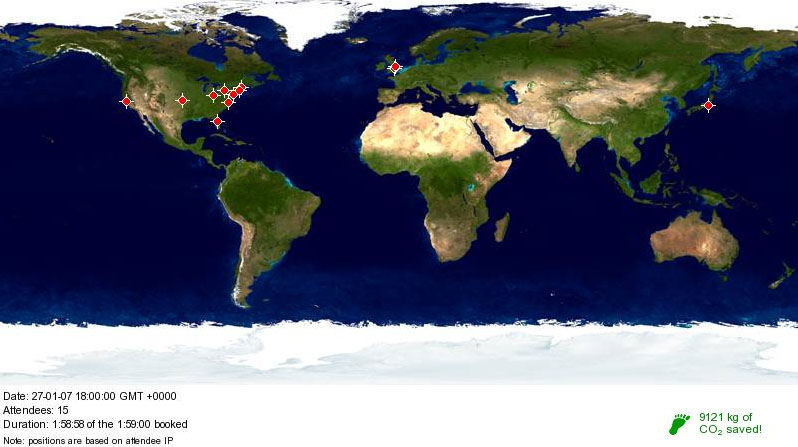
As Internet connections get faster and webcams cheaper, desktop videoconferencing appears to be the most appropriate solution for virtual communication. Video meetings can be very effective providing new ways of collaboration and saving the environment, as well as the travelling time and expenses.
Using FM to conduct a meeting is a lot 'greener' than travelling long distances and helps to reduce your carbon footprint (the impact your activities have on the environment, especially greenhouse gasses).
The following map shows 15 attendees of one live meeting spread across North America, Europe and Asia, saving 9,121 kg of carbon dioxide!

We have implemented a 'carbon calculator', which shows the approximate amount of CO2 that aircraft flying people to and from the meeting would have produced.
For those interested here is a description of how the figure is calculated:
We loop through all of the attendees of the meeting and calculate how far each of the other attendees would have to travel to get to their location. From this we choose the shortest of these totals, to find the person the attendees could have chosen to travel to, in order to travel the shortest distance. Distances are calculated using the 'great circle' distance on the Earth's surface (i.e. we assume a 'sphere' and it is the shortest surface distance).
The figures for flights were taken from the web page: http://www.climatecrisis.net/takeaction/carboncalculator/howitwascalculated.html (no longer available)
We use the figures listed on this web page to calculate the amount of CO2 that would have been used. The appropriate consumption figures are then applied to each individual's journey. Finally the total is doubled because presumably the trip would include a return journey!
Some of the assumptions and inaccuracies:
|
Examples of C02 volume to weight equivalents |
|||
|
|
|
|
Hot Air Balloon |
Zeppelin |
15 Party Balloons |
Breathing for a day |
Density of Carbon Dioxide: |
|||
For more For more information, please contact:
Dr Kevin Quick
The Knowledge Media Institute,
Open University, UK